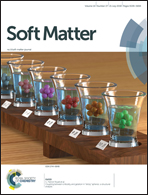Cargo carrying bacteria at interfaces†
Abstract
The displacements of ensembles of colloids at the interface between oil and suspensions of the bacterium Pseudomonas aeruginosa PA14ΔpelA indicate enhanced colloid mobilities and apparently diffusive motion driven by interactions with the bacteria. However, inspection of individual trajectories of ∼500 particles reveals prolonged, directed displacements inconsistent with purely hydrodynamic interactions between swimming bacteria and colloids. Analysis of the properties of colloid paths indicates trajectories can be sorted into four distinct categories, including diffusive, persistent, curly, and mixed trajectory types. Non-diffusive trajectories are the norm, comprising 2/3 of the observed trajectories. Imaging of colloids in the interface reveals anisotropic assemblies formed by colloids decorated with one or more adhered bacteria that drive the colloids along these paths. The trajectories and enhanced transport result from individual colloids being moved as cargo by these adhered bacteria. The implications of these structures and open questions for interfacial transport are discussed and related to the active colloid literature.



 Please wait while we load your content...
Please wait while we load your content...